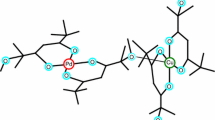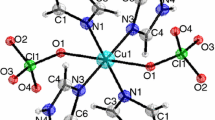Abstract
Strain measurement and quasiequilibrium thermogravimetry were used to study the dissociation processes of two clathrates, [Ni(MePy)4(NCS)2]·(MePy) and [Cu(MePy)4(NCS)2]·2/3(MePy), accompanied by the liberation of MePy into the gaseous phase. In the Ni clathrate dissociation process in the temperature range 298–368 K the liberated MePy was redistributed between the solid clathrate and gaseous phases; the MePy vapour pressure over the clathrate is a function of temperature and the guest contenty, which agrees with the presence in the MePy-[Ni(MePy)4(NCS)2] system of a wide range of β-clathrate solutions, [Ni(MePy)4(NCS)2]·y(MePy). The same methods used to study the Cu clathrate dissociation resulted in conclusions different from those obtained for the dissociation process of the above clathrate: the process is described by the equation [Cu(MePy)4(NCS)2]·2/3(MePy)solid =[Cu(MePy)2(NCS)2]solid+22/3(MePy)gas; the temperature dependence of the Mepy vapour pressure over the solid sample does not depend on its composition, which points to the absence from the system of solid solutions based on the clathrate. Standard changes of the enthalpy, entropy, and isobaric-isothermal reaction potential for the temperature range 292–325 K are equal to 178.6±1.7 kJ (mole of clathrate)−1, 463±5.6 J (mole of clathrate)−1 K−1, and 40.4±2.4 kJ (mole of clathrate)−1, respectively.
Similar content being viewed by others
References
W. Kemula, J. Lipkowski, and D. Sybilska:Rocz. Chem. 48, 3 (1974).
S. Brzozowski and M. Broniarek:Rocz. Chem. 48, 1213 (1974).
J. Chajn, J. Lipkowski, and W. Zielenkiewicz:Rocz. Chem. 51, 1431 (1977).
J. Lipkowski and J. Chajn:Rocz. Chem. 51, 1443 (1977).
G.V. Gavrilova, N.V. Kislykh and V.A. Logvinenko:J. Therm. Anal. 33, 229 (1988).
N.V. Kislykh, Yu.A. Dyadin, N.V. Pervukhina, I.V. Davydova, and N.V. Podberezskaya:Izv. Sib. Otd. Akad. Nauk SSSR, Ser. Khim. Nauk 3, 76 (1989);Chem. Abstr. 111, 141646n (1989).
J. Lipkowski and S. Majchrzak:Rocz. Chem. 49, 1655 (1975).
N.V. Pervukhina, N.V. Podberezskaya, I.V. Davydova, N.V. Kislykh, and Yu.A. Dyadin:J. Incl. Phenom. 13, 9 (1992).
J. Lipkowski, Yu.A. Dyadin, and N.V. Kislykh: manuscript.
G.D. Andreetti, G. Bocelli, and P. Sgarabotto:Cryst. Struct. Commun. 1, 51 (1972).
S.A. Allison and R.M. Barrer:J. Chem. Soc. A 1717 (1969).
Yu.A. Dyadin and N.V. Kislykh:Mendeleev Commun. 134 (1991).
M.R. Caira, L.R. Nassimbeni, N. Winder, E. Weber, and A. Wierig:Supramol. Chem. 4, 135 (1994).
L.J. Barbour, K. Achleitner, and J.R. Greene:Thermochim. Acta 205, 171, 1992.
W.D. Schaeffer, W.S. Dorsey, D.A. Skinner, and C.G. Christian:J. Am. Chem. Soc. 79, 5870 (1957).
C.G. Jackson:J. Chem. Soc. 99, 1066 (1911).
A.V. Suvorov:Termodinamicheskaya khimiya paroobraznogo sostoyaniya. Tenzimetricheskiye issledovaniya geterogennykh ravnovesij, pp. 46–51. Khimiya, Leningrad (1970) (in Russian).
F. Paulik and J. Paulik:J. Therm. Anal. 5, 253 (1973).
Yu.A. Dyadin, G.N. Chekhova, and N.P. Sokolova:J. Incl. Phenom. 5, 187 (1987).
The thermal effect corresponding to this fracture was not observed in the course of the study of the system phase diagram which might be due to its being small, or some other reasons.
E.F.H. Herington and I.F. Martin:Trans. Faraday. Soc. 49, 154 (1953).
Author information
Authors and Affiliations
Rights and permissions
About this article
Cite this article
Ukraintseva, E.A., Dyadin, Y.A., Kislykh, N.V. et al. Vapour pressure of 4-methylpyridine (MePy) over [Ni(MePy)4(NCS)2]·y(MePy) and [Cu(MePy)4(NCS)2]·2/3(MePy) clathrates during their dissociation. J Incl Phenom Macrocycl Chem 23, 23–33 (1995). https://doi.org/10.1007/BF00706946
Received:
Accepted:
Issue Date:
DOI: https://doi.org/10.1007/BF00706946




